The Royal School of Needlework has begun publishing a series of “essential stitch guides” for various needlework techniques. The first two to come out in the series are on crewelwork and blackwork, and it looks as if two more will not be long in coming.
The title of the series indicates exactly what the books are: guides to the essential stitches used in the given technique. Keep in mind that they are not project books – you won’t find any practice projects in them, or anything of that nature. Rather, you’ll find the essential information for getting started (and progressing) in the needlework technique.
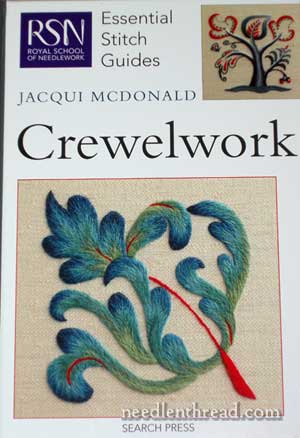
The Essential Stitch Guide to Crewelwork is small (about 6″ x 8″), hard bound, with a spiral binding hidden in the spine, so that the stitch guide lies flat.
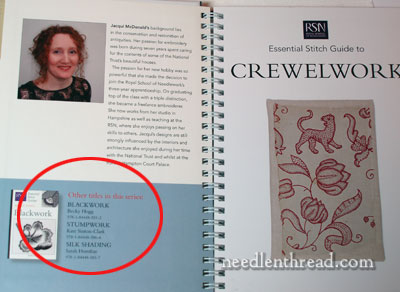
The book begins with an introduction to the author. All the authors are graduates of some level of the Royal School of Needlework. Incidentally, you can see that there are two more stitch guides announced here – one for stumpwork and one for silk shading.
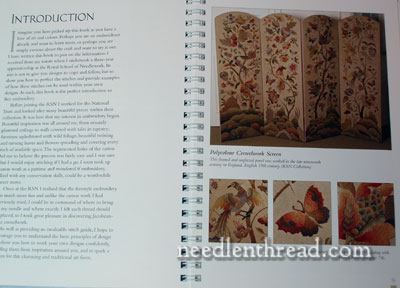
Like most technique-specific needlework books, the crewelwork stitch guide begins with an introduction to crewelwork. You can see that there are plenty of colored photos of crewelwork throughout the book (the photos are actually very clear and colorful – not dark – that’s just my bad photography!)
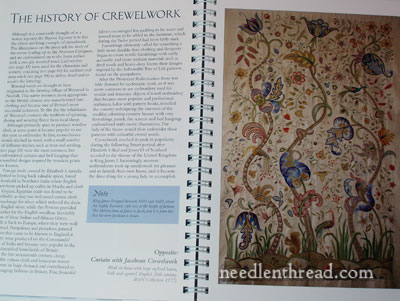
There’s also a brief bit on the history of crewelwork. Don’t expect super-detailed history here; it’s the bare bones of the development of crewelwork, which I think is fine for a technique manual.
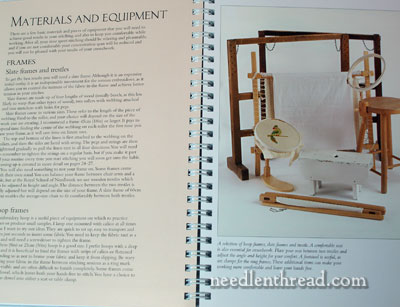
Again, like most embroidery how-to’s, there’s a nice section on equipment, focusing mostly on the traditional equipment used in embroidery, and still used by the Royal School of Needlework. There’s talk on frames and hoops – you won’t see Q-snaps here!
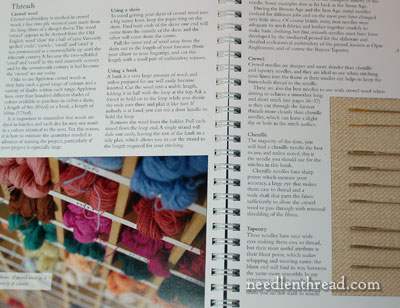
Next up, there’s good information on threads and needles, with a handy diagram of needle types.
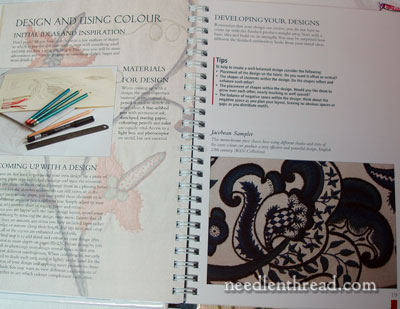
There’s also a brief section on designing and color choice – again, the information isn’t in-depth and detailed, but it is enough to get one started in the technique and to help guide various choices the stitcher would make when considering a design.
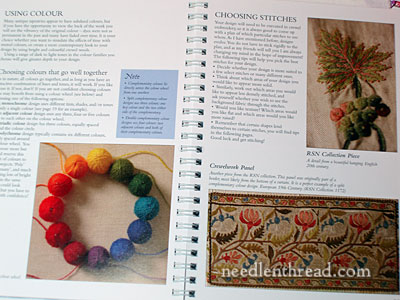
Well, I happen to like the color section… It’s those balls of wool threads. They’re threads, they’re colorful, and I am a sucker for pictures of thread. The information is good, too!
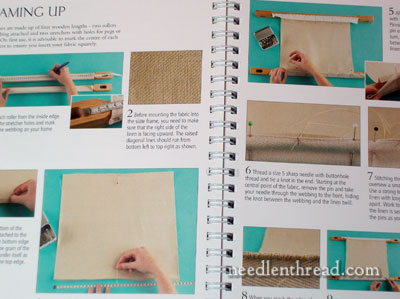
Many technique books address the setting up of the project – framing, transferring, and so forth – and this book is no exception. I really like the detail here on setting up a slate frame. Good information!
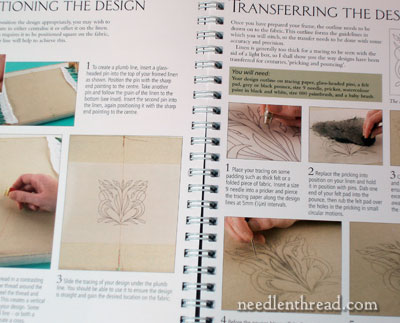
And the information on transferring the embroidery design is also excellent. There’s a good bit on using the prick-and-pounce method, which is good to know, especially when working on heavier fabrics that may not trace well on a light table.
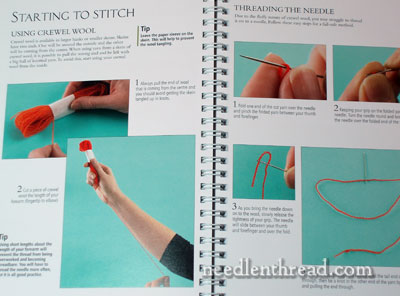
More start-up info here – something not necessarily addressed in every technique book. This is a nice spread on handling the skeins of crewel yarn, pulling the thread out from the correct place, measuring a stitchable length, and threading the needle.
All this introductory information is quite helpful for getting a project underway correctly.
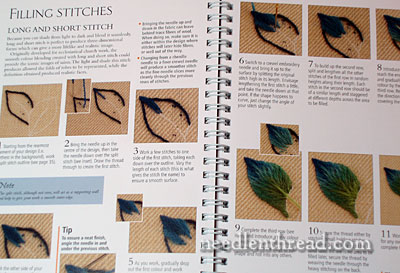
But the meat of the matter in any technique book is the technique. Using clear step-by-step photos, the book focuses on all the essential stitches used in crewelwork, arranging them according to type – filling stitches, line stitches, etc.
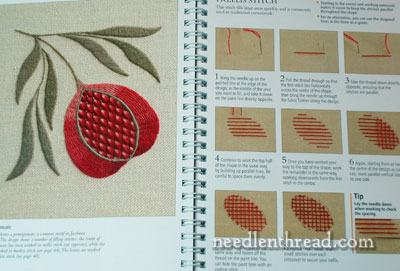
Did I mention that the photos throughout the book are beautiful? While the book may not feature specific crewel projects, it certainly features plenty of inspirational photos. I just love this pomegranate! And next to it, you can see the lattice work filling demonstrated step-by-step.
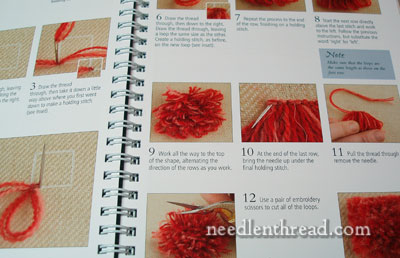
Plenty of stitches are demonstrated, and I have to admit, this is the “lushest” tutorial on Turkey Work!
The tutorials are all clear and concise, with easy to follow text instructions that correspond with the photos.
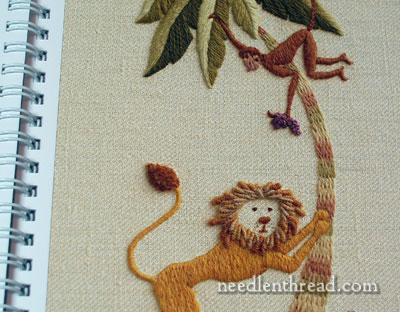
And in case you’re afraid that all the pictures of serious subject-matter for serious embroidery, there’s this lion-monkey piece in the back of the work that’s perfectly whimsical!
Pros:
1. I’m glad the book doesn’t devote heavy duty coverage to history and so forth. It’s a stitch guide, and that’s what I bought it for. There’s enough there to satisfy, but not enough to weigh down the reader in the details.
2. It covers just what it promises – essential stitches for crewelwork – and it covers them well, with clear step-by-step photos and text instructions.
3. The information on framing up and transferring is excellent – it’s everything that you need to know to get started on a crewelwork project.
4. I like the format of the book – a small book, with a spiral binding, meant to be used while you work.
5. The price is right – it can be found for under $15 new in the US.
Cons (and they depend on what you look for in a technique book):
The book does not get the beginner started with a project. If you are expecting that, this is the wrong book for you! Many of the Search Press books (for example, The Beginner’s Guide to Goldwork by Ruth Chamberline) feature projects or samplers to get the beginner started. But the book doesn’t claim to be that. It’s a stitch guide, so I don’t really find this to be too much of a problem.
Overall, I really (really!) like these stitch guides so far. I think they’ll be a worthwhile series to have on your reference shelf. They give you enough to get started well in a given technique, and they do it for a good price. While I love Country Bumpkin’s A-Z series for different techniques, I usually have to look for them on sale, as the price tag can be somewhat prohibitive. The RSN books run less than half the price, but admittedly, they don’t have as much content.
Where to Find It
You can find the RSN’s essential stitch guide for Crewelwork available through the following book affiliates:
In the US, Crewelwork essential stitch guide is available here through Amazon.
Worldwide with free shipping, you’ll find the Crewel Work essential stitch guide available here through Book Depository.







I just received my copy of this book within the last few days. I heartily agree with your assessment, Mary. It’s a very nice book. (I love the picture with the colour wheel done in balls of wool.)
I’m looking forward to the stumpwork and silk shading editions!
Here we are again, Mary!
What a temptation! And soon another about blackwork? OMG!
I think I’ve said before but I’ll say again the crewel patterns reminds me the Castelo Branco embroidery but this made with silks, remember? Your fourth photo looks like CB embroidery.
And one question I think you’ve already written about: which is the difference between Turkey stitch and Velvet stitch? Are they the same? I think not… but similar…
Mary, I am seduced by books, glorious color, and handwork so guess what I did after reading today’s entry. Yes, I immediately ordered the two RSN books as well as the one on beginning goldwork. Thank you for placing temptation in my path! After all, just think of all the serious addictions I could have had in place of these. Have a serene day – Noel
Hi, all! Yep, it’s a good little book – definitely worth having as a reference!
The blackwork one is equally good – I’ll be reviewing it later in the week. It’s the best blackwork book I’ve come across, actually, because it gets into the nitty-gritty about certain techniques… but more on that later!
~MC
Ok enabler par excellence! I have ordered the book. I now feel I could not possibly live without it!!! (smile)
Mary:
Another lovely review. I received both of these for Christmas (I am addicted to books!) and love them, especially the way they lay so flat. Of the two, I like the blackwork one more, but that may be because I am not as familiar with that technique and it is my only book on the subject! The stitching/shading explanation is great.
Hi Mary !
I love reading your book discussions.
Thank you !
OK – Before, I wanted this book. Now I Neeeeed It, even tho I won’t be able to start a crewel work project for awhile.
i m fond of embriodery designs.n want to pick this book in India plz tell me how can i purchase these books
The book sounds and looks terrific, and the price is reasonable. Hopped online and ordered both the crewel and blackwork books, and preordered the stumpwork. Listed as available in August.
Dear Marymentor:
I’ve now ordered, on your recommendation, TWO books within ONE week’s time ….and I know I’ll be pleased with both ! Thanks again for your continuing tutelage and suggestions….Grateful in Pittsburgh….Judy
Hi Mary C.
I joined your website @ 1 week ago and have already gotten more usefull and entertaining information here than enywhere else, including the vast array of books I have accumulated. I
am a fiber arts enthusiast, but have skirted around real needle work for a long time. Your videos and articles have given me the inspiration to jump in with confidence. Thanks so much and I hope you continue your website for a long, long time.
Doreen
Fantastic really. I appreciate them. Thanks.
Hi Mary
I bought this book after reading your review and it now lives in my embroidery bag with other essential equipment. What a jewel you are!
hola que libro tan bueno. vivo en colombia donde puedo comprarlo. o si alguien puede explicarme alguna puntadas les agradezco. mi correo es sogujo@hotmail.com
I have just bought this book last month and it is my first book on crewel work – now I am totally addicted. I had the pleasure of visiting the RSN last week and yes I gave into temptation and bought the pomegranate kit – it is a delight to sew (especially as it was bought at the RSN!!)
Like the blackwork book I will be using this one alot